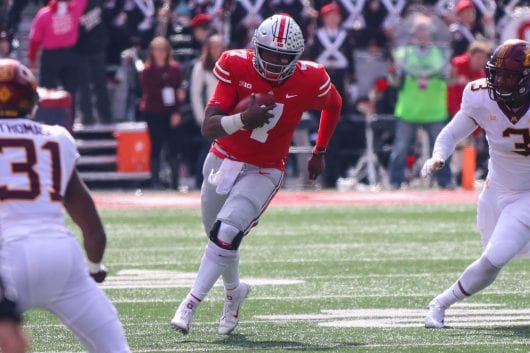
Ohio State redshirt sophomore quarterback Dwayne Haskins (7) runs the ball in the third quarter of the game against Minnesota on Oct. 13. Ohio State won. 30-14. Credit: Casey Cascaldo | Photo Editor
Ohio State might be the No. 2 team in the country, with a 7-0 record and have its best throwing quarterback in recent memory in redshirt sophomore quarterback Dwayne Haskins.
But the team is lacking one thing every team led by head coach Urban Meyer has always had: a run game.
In the Buckeyes 30-14 win over Minnesota, Ohio State failed to reach 100 rushing yards for the first time since its loss to Clemson in the College Football Playoff two seasons ago.
Much of this can be attributed to Ohio State’s lack of a dual-threat quarterback, with J.T. Barrett amassing 798 rushing yards in his redshirt senior season last year, much of which was through the run-pass option, or RPO.
Barrett was often the answer to short third-down plays, and the extra threat with his feet allowed more space for running backs J.K. Dobbins and Mike Weber. So much more space, in fact, that Dobbins ran for 1,403 yards and 7.2 yards per carry as a freshman.
The RPO seems to have been majorly lost with Barrett’s departure, but Meyer said that is not necessarily true.
“A lot of those passes are RPOs, like when you see Parris [Campbell] in the flat or K.J. [Hill] on a hitch, those are all RPOs,” Meyer said. “You’re reading someone, you trigger, you throw the ball. So I’d say there’s at least 10 to 12 called runs that the ball is being thrown.”
This season, Haskins has 30 rushes for 49 yards and a touchdown on the ground, averaging 1.9 yards per carry. Against Minnesota, Haskins had a career-high nine carries and totaled just six yards, losing yardage on three sacks.
However, the RPO for Haskins is still completely different than the play-calling Barrett had under Meyer.
Instead of Haskins running the ball himself when an RPO is called, he is looking for an opportunity to hand the ball off, finding a hole for whichever running back is in the game, whether its Dobbins or Weber.
However, instead of Dobbins and Weber putting up the same types of numbers they combined for last season, the Ohio State rushing game has struggled, ranking as the No. 51 rushing offense in the NCAA with the yards per carry average for both backs decreasing from a season ago.
The defensive schemes Ohio State has seen over the first seven games of the season has indicated that opponents view the rushing offense, without a dual-threat option behind center, as one-dimensional.
“I don’t want to give you a number, but there’s some pass yards that are run plays,” Meyer said. “They’re loading the boxes, we’re not going to run the quarterback.”
To make up for it, Haskins threw 412 yards and three touchdowns, giving him back-to-back 400-yard passing games. The Ohio State program has had three 400-yard passing games in its history, two coming in the past two weeks.
While Barrett gave the offense a strong weapon on both fronts, Haskins has been making up for lost ground by drastically out-throwing any season Barrett ever had.
In the RPO, Meyer said he understands this difference, and that’s why there has been such a shift in the offensive numbers.
“We went back and studied everything, and had that conversation about these are 10 run calls that we’re flipping the ball out there and making plays with it,” Meyer said. “That’s kind of what Dwayne gives you. Maybe J.T. gave you something else, where it was more of a run-run option; this is a run-pass option.”
The Buckeyes will travel this Saturday to face a Purdue rush defense that has been middle of the road so far this season, allowing 146.8 yards per game and four yards per carry to opposing backs.
It remains to be seen if the Ohio State offense will move toward the run aspect of the run-pass option, or if the offense can continue to survive on the historic pace that Haskins’ passing game is working on.


